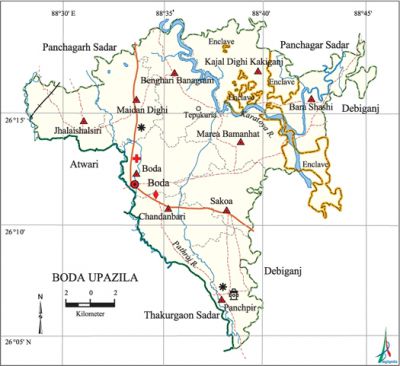Boda Upazila
Boda Upazila (panchagarh district) area 349.47 sq km, located in between 26°05' and 26°23' north latitudes and in between 88°27' and 88°46' east longitudes. It is bounded by panchagarh sadar upazila on the north, thakurgaon sadar and debiganj upazilas on the south, Debiganj upazila on the east, atwari, Thakurgaon and Panchagarh Sadar upazilas on the west. Indian enclaves such as Nagirganj, Shalbari, Meyelia, Doikhata, and Maidandighi belong to this upazila.
Population Total 200693; male 103229, female 97464; Muslim 152282, Hindu 47928, Buddhist 320 and others 163.
Water bodies Main rivers: karatoya, tangon, Pathraj.
Administration Boda Thana, now an upazila formed in 1883. After the partition of India in 1947 this upazila was included into Thakurgaon Sub Division of Dinajpur district and in 1984 it was included into Panchagarh district.
| Upazila | ||||||||
| Municipality | Union | Mouza | Village | Population | Density (per sq km) | Literacy rate (%) | ||
| Urban | Rural | Urban | Rural | |||||
|
- |
10 |
174 |
239 |
6930 |
193763 |
574 |
58.2 |
42.5 |
| Upazila Town | ||||||||
|
Area (sq km) |
Mouza |
Population |
Density (per sq km) |
Literacy rate (%) | ||||
|
4.17 |
3 |
6930 |
1662 |
58.2 | ||||
| Union | ||||
| Name of union and GO code | Area (acre) | Population | Literacy rate (%) | |
| Male | Female | |||
|
Kajal Dighi Kaliganj 58 |
10181 |
12006 |
11300 |
37.48 |
|
Chandanbari 29 |
6998 |
9873 |
9374 |
43.40 |
|
Jhalaishalsiri 51 |
6942 |
8518 |
8106 |
45.45 |
|
Panchpir 87 |
6864 |
9693 |
9125 |
44.82 |
|
Bara Shashi 7 |
18080 |
12550 |
12276 |
38.69 |
|
Benghari Banagram 14 |
7991 |
10688 |
9504 |
40.88 |
|
Boda 21 |
7991 |
12023 |
11361 |
51.60 |
|
Maidan Dighi 73 |
7555 |
9662 |
9118 |
46.09 |
|
Marea Bamanhat 80 |
7131 |
9486 |
9237 |
40.46 |
|
Sakoa 94 |
6171 |
8730 |
8063 |
42.11 |
Source Bangladesh Population Census 2001, Bangladesh Bureau of Statistics.

Archaeological heritage and relics Chandanbari Mosque, Vadeswari Temple, Govinda Temple, Golok Dham Mandir.
Historical events The people of this upazila actively participated in peasant movement against Devi Singh (end of 18th century), fakir-sannyasi resistance (1763-1800), sepoy revolt (1857), tebhaga movement (1938-1947), peasant movements (1958-68) and mass upsurge of 1969. A number of guerrilla attacks were held in this upazila during the nine month war of liberation. The Pak army in collaboration with the rajakars conducted heavy torture in the upazila. The Pak army captured Boda town on 18 April 1971. Boda was liberated on 1 December 1971.
Religious institutions Mosque 368, temple 12, tomb 2. Noted religious institutions: Chandanbari Mosque, Vadeswari Temple, Govinda Temple, Golok Dham Mondir, Bara Shashi Tomb and tomb of Manikpir.
Literacy rate and educational institutions Average literacy 43.1%; male 48.9%, female 36.9%. Educational institutions: college 10, secondary school 50, primary school 168, satellite school 80, madrasa 40. Noted educational institutions: Pathraj College (1973), Boda English High School (1888), Boda Pilot High School (1888), Maidan Dighi BL High School (1929), Nayadighi Primary School (1828), Goalpara Primary School (1830), Boda Ideal Primary School (1873).
Newspapers and periodicals Surya Uthe (1972), Gana Patra (1988), Chetana (2006).
Cultural organisations Library 5, club 40, theatre stage 1, cinema hall 4.
Tourist spots Vadeswari Temple, Golok Dham Mondir, Nayaniburuj and Nayadighi.
Main sources of income Agriculture 75.19%, non-agricultural labourer 2.91%, industry 0.32%, commerce 9.5%, transport and communication 4.61%, service 3.63%, construction 0.93%, religious service 0.16%, rent and remittance 0.1% and others 2.65%.
Ownership of agricultural land Landowner 59.95%, landless 40.05%; agricultural landowner: urban 38.16% and rural 60.73%.
Main crops Paddy, jute, wheat, sugarcane, mustard. Extinct or nearly extinct crops Aux rice, kaun, demsi.
Main fruits Mango, jack fruit, litchi, banana, betel nut.
Communication facilities 'Roads: pucca road 70 km, semi pacca road 5 km, mud road 543.66 km; railways 3 km.
Extinct or nearly extinct traditional transport Palanquin, horse carriage, bullock cart.
Noted manufactories Husking mill 30.
Cottage industries Potteries, Bamboo work, nakshi kantha.
Hats, bazars and fairs Hats and bazars are 138, fairs 3, most noted which are Boda Hat, Sakoa Hat, Sareya Hat, Maidan Dighi Hat, Panchpir Hat, Jhalaishalsiri Hat, Tepukuria Hat, Fultala Hat, Mondaler Hat and Baruni Mela, Boalmari Melaand Maidan Dighi Mela.
Main exports Paddy, jute, betel nut, wheat.
Access to electricity All the unions of this upazila are under rural electrification net-work; however 7.59% dwelling households have access to electricity.
Sources of drinking water Tube-well 81.66%, pond 0.48%, tap 0.23% and others 17.62%.
Sanitation 28.38% (urban 64.77% and rural 27.08%) of dwelling households of the upazila use sanitary latrines and 17.8% (urban 12.98% and rural 17.97%) of dwelling households use non-sanitary latrines; 53.82% of households do not have latrine facilities.
Health centres Upazila health complex 1, family planning centre 9, satellite' clinic 2, clinic 5.
ngo activities brac, CARE, asa. [Md. Ahsan Habib]
References Bangladesh Population Census 2001, Bangladesh Bureau of Statistics; Cultural survey report of Boda Upazila 2007.
